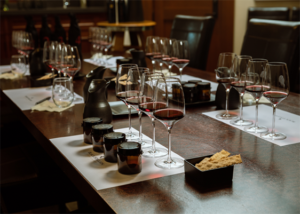For more than four decades, we would travel to California at least once a year to go wine tasting. Occasionally we’d go to the Central Coast or a smaller, outlying sector of California’s Wine Country, which means most of the state. But usually our destination was either Napa Valley or Sonoma County, sometimes both. Then the pandemic came along, and like a lot of people, our travels were interrupted for a few years.
For a long time, planning for a wine tasting trip was fairly simple: flight, car and hotel. The rest was mostly a matter of serendipity. We’d choose an AVA, drive there and stop wherever we wanted. We would park, walk in, belly up to the bar and taste. When we were finished, we’d get back into the car and head up the road to do it again.
For better or worse, more planning is required these days.
- It still makes sense to limit a day’s tastings geographically. We want to be tasting, not driving from Calistoga to Napa and then back to St. Helena. Why waste time behind the wheel when we could be in a tasting room? More important, when the purpose of the day’s activities is sipping alcohol, it’s really advisable to minimize driving as much as possible.
- Appointments are necessary. Many wineries now have a “By Appointment Only” policy. Smaller wineries – and some of the larger, snootier ones – have long been that way. That prohibition was once a ruse to keep rowdy crowds away; today the tastings are seated and the limitation is for real. Since the pandemic, almost all Napa/Noma wineries are available only with a reservation.
A seated tasting at Black Stallion. Photo courtesy of the winery.
- Expect fewer but longer seated tastings. Many wineries, as a by-product of their appointment requirements, now only offer seated tastings. Bellying up to the bar is not an option anymore or there is no bar to belly up to. Therefore, we taste on their schedules rather than our own. The ambiance is more guest than bar patron, which has plusses and minuses.
- Sharing is more difficult. Since they are seated tastings, two people can’t occupy one chair. As a result, both will have a full tasting. Sure, we can each sip only a little but the temptation to take a few more sips is quite apparent and the cost of tasting becomes more expensive.
- Lunch is more important than ever, but harder. If we are likely to drink a little more at each tasting, we need to get some food into us. But fitting in a restaurant between winery visits is a challenge, especially in areas where restaurants are few and far between.
- Packing a picnic may be the only choice. There are no restaurants and often not even delis in certain areas. For example, there used to be the Jimtown Store in Alexander Valley, but there isn’t anything now. And try finding a restaurant in the further extremes of Russian River. Even with a packed lunch, there aren’t that many wineries with picnic tables in Sonoma County and hardly any at all in Napa Valley. Dining in the car may be necessary but it’s unpleasant.
All of which is to say, Napa/Noma still has some of America’s best wineries available to visit. They just take more preparation to enjoy them than it used to.
